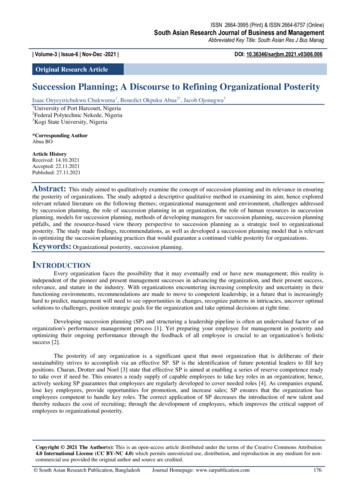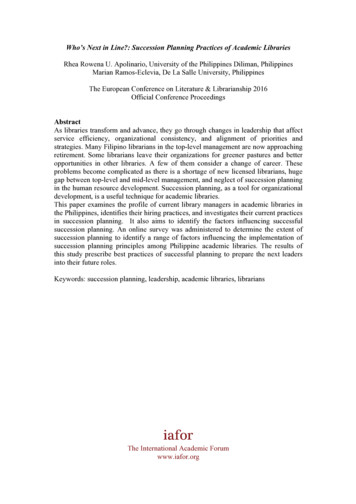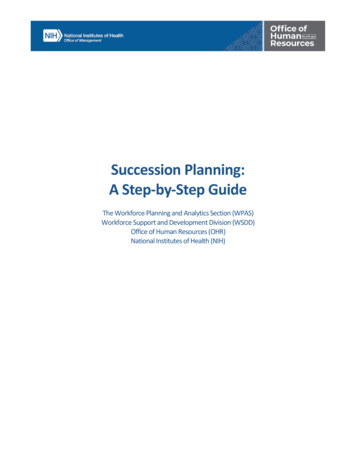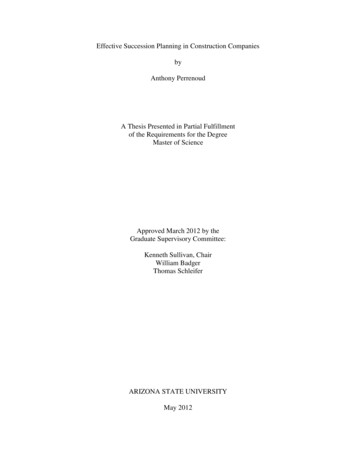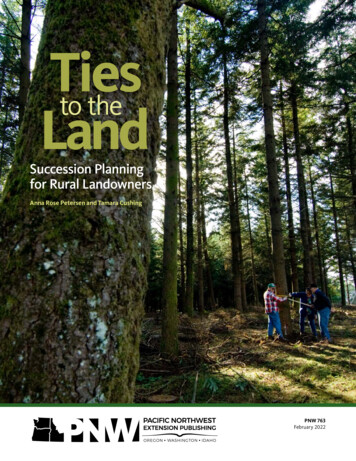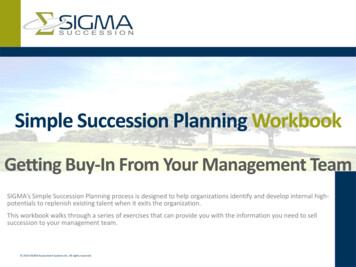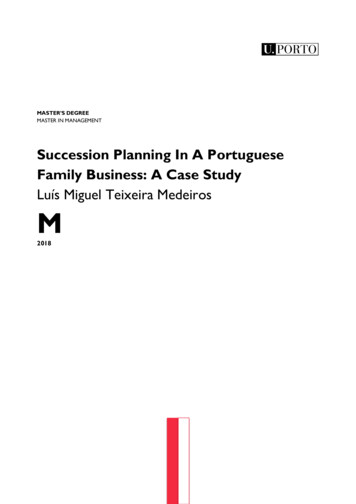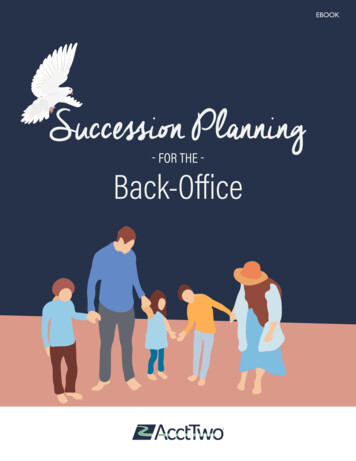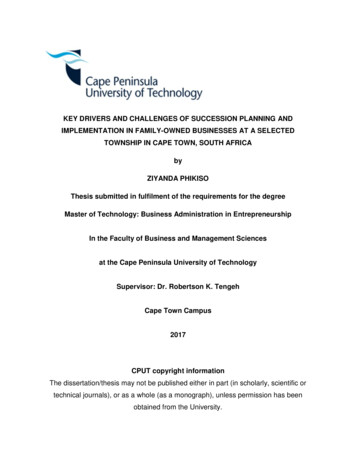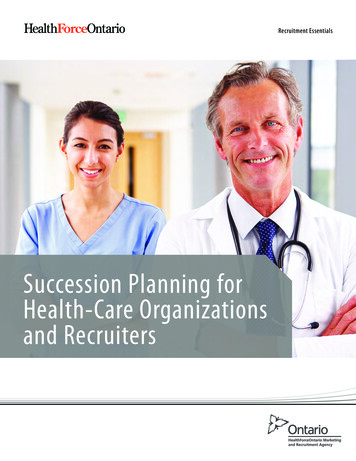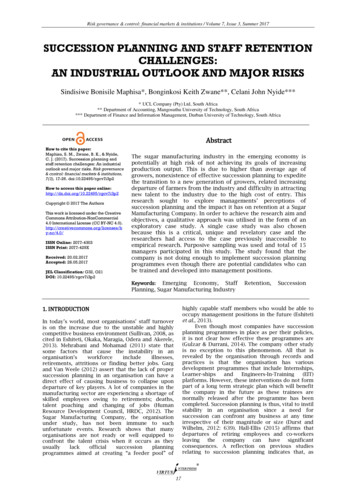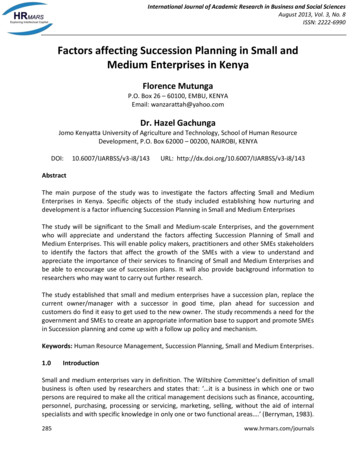
Transcription
International Journal of Academic Research in Business and Social SciencesAugust 2013, Vol. 3, No. 8ISSN: 2222-6990Factors affecting Succession Planning in Small andMedium Enterprises in KenyaFlorence MutungaP.O. Box 26 – 60100, EMBU, KENYAEmail: wanzarattah@yahoo.comDr. Hazel GachungaJomo Kenyatta University of Agriculture and Technology, School of Human ResourceDevelopment, P.O. Box 62000 – 00200, NAIROBI, KENYADOI:10.6007/IJARBSS/v3-i8/143URL: tThe main purpose of the study was to investigate the factors affecting Small and MediumEnterprises in Kenya. Specific objects of the study included establishing how nurturing anddevelopment is a factor influencing Succession Planning in Small and Medium EnterprisesThe study will be significant to the Small and Medium-scale Enterprises, and the governmentwho will appreciate and understand the factors affecting Succession Planning of Small andMedium Enterprises. This will enable policy makers, practitioners and other SMEs stakeholdersto identify the factors that affect the growth of the SMEs with a view to understand andappreciate the importance of their services to financing of Small and Medium Enterprises andbe able to encourage use of succession plans. It will also provide background information toresearchers who may want to carry out further research.The study established that small and medium enterprises have a succession plan, replace thecurrent owner/manager with a successor in good time, plan ahead for succession andcustomers do find it easy to get used to the new owner. The study recommends a need for thegovernment and SMEs to create an appropriate information base to support and promote SMEsin Succession planning and come up with a follow up policy and mechanism.Keywords: Human Resource Management, Succession Planning, Small and Medium Enterprises.1.0IntroductionSmall and medium enterprises vary in definition. The Wiltshire Committee’s definition of smallbusiness is often used by researchers and states that: ‘ it is a business in which one or twopersons are required to make all the critical management decisions such as finance, accounting,personnel, purchasing, processing or servicing, marketing, selling, without the aid of internalspecialists and with specific knowledge in only one or two functional areas .’ (Berryman, 1983).285www.hrmars.com/journals
International Journal of Academic Research in Business and Social SciencesAugust 2013, Vol. 3, No. 8ISSN: 2222-6990The term SME covers a wide range of definitions and measures, varying from country tocountry and between the sources reporting SME statistics. In developing countries the numberof employees and the size of assets or turnover for SME tend to be much smaller compared totheir counterparts in developed countries due to their relative size of business entities andeconomies (Nation Media and KPMG, 2011).In Kenya, types of Small Scale Businesses include; survivalist enterprises which are activities bypeople unable to find a paid job or get into an economic sector of their choice. Microenterprises are very small business, often involving only the owner, some family member(s) andat the most one or two paid employees. Medium enterprises constitute a category difficult todemarcate vis-a -vis the ‘small’ and ‘big’ business categories. Kenya has about 1.6 millionregistered small and medium enterprises constituting about 96% of all business enterprises inthe country (KPMG and Nation Media Group, 2004).A recent survey dubbed, the annual top small and medium enterprises in East Africa that iscarried out by audit firm KPMG and Nation Media Group found out that revenue growth washighest in the past 12 months for small businesses in construction at 61%, services 46% andinformation technology 44% - segments of the economy reflecting the intensity of activity inthe sectors. Majority of these small and medium enterprises are family owned business unitswith the family member being the majority shareholders. They are also known for their poorbook keeping records and the secrecy in which they conduct their businesses. (KPMG andNation Media Group, 2004).Small and Medium Enterprises are generally distinguished by the nature of their production andmanagement arrangements, trading relations, financial practices, and internal competenceamong others. The major characteristics of small and medium enterprises are:- small units,often rural-based and family-owned; small independent enterprises, standing alone andproducing for a well-defined market; specialized firm, producing specialized products, selling tothe international and or local markets; rely on low cost raw materials, low energy costs, lowlabor costs, low division of labor; flexible and often small production runs; low capital formationand largely labor intensive units with low-level technologies; but note the emergence of highskill and technology-intensive small and medium enterprises, especially in high technologyindustries (World Bank, 2007).The development of Small and Medium Enterprises has been hindered by political instability orstrong dependence on a few raw materials as opposed to a fairly modern financial systems andclear government policies in favor of private enterprise. Small and Medium Enterprises areweak in Africa because of small local markets, undeveloped regional integration and verydifficult business conditions, which include cumbersome official procedures, poorinfrastructure, dubious legal systems, inadequate financial system and unattractive tax regimes(World Bank, 2007). Many firms stay small and informal and use simple technology that doesnot require great use of national infrastructure. Their smallness also protects them from legalproceedings so they can be more flexible in uncertain business conditions (MSME Brochure,2007).286www.hrmars.com/journals
International Journal of Academic Research in Business and Social SciencesAugust 2013, Vol. 3, No. 8ISSN: 2222-6990A family-owned enterprise is a ‘total system’ that is derived from a number of sub-systems,including the founding entrepreneur as an entity, the family member as an entity and theenterprise as an entity (Dyer and Handler, 1994). Successful succession can provide a familyowned business with a competitive edge over a non-family-owned business by enabling thecontinued use of accumulated idiosyncratic knowledge of family members (Bjuggrenand Sund,2001). The inside knowledge possessed by family members, coupled with their loyalty andtrust, endows them with specific competencies and know-how required to run the businesseffectively and helps them to create the resources and capabilities required to generate acompetitive advantage (Ram and Jones, 2002). In professionally managed firms, boards ofdirectors often make succession decisions by utilizing a professional recruitment consultancyservice. In such firms, the successor is selected from a pool of candidates on the basis ofperceived competency.1.1Statement of the ProblemIn family-owned businesses there are a few people in either the business or the family with anyexperience of when and how succession should be dealt with, as this issue is a rare event forthe family firm occurring only once for each generation (Fox et al, 1996). Consequently one ofthe most pressing problems for the family-owned business is planning to pass control of thebusiness to the next generation (Kuratko et al, 1993), with succession a problematic andneglected issue in many family business (Bachkaniwala et al, 2001). Succession planning is anexplicit process by which the firm will be transferred to the family’s next generation. Whilst thesuccessful succession of CEOs is a crucial goal for these firms, without the next generation’sleadership and direct management, the firm cannot survive as a family-owned business letalone maintain its character (Barach & Ganitsky 1995).One of the most central problems facing family-owned businesses is the ability to ensurecompetent family leadership across the generations. Only one third of family businesses surviveinto the second generation, and only about 10% to 15% make it into the third generation(Birley, 1986; Ward, 1987). Poor successions are often the source of the problem (Miller, Steier,& Le Breton-Miller, 2003).In family-owned businesses there is often a smaller pool of talent on which to draw,complicating emotional factors in the incumbent-successor relationship, and complex social tieswith the family (Dyer, 1986; Lansberg, 1999; Miller, Steier, & Le Breton-Miller, 2003). Accordingto the Kenya National Bureau of Statistics, 2007; three out of five businesses fail within the firstfew months of engagement. Data on the Micro, Small and Medium Enterprises sector in Kenyais scarce. The National Small and Medium Enterprises Baseline Survey provides comprehensiveand reliable information, it has not been updated since 1999 and does not contain informationon Succession Planning for Medium-sized firms.287www.hrmars.com/journals
International Journal of Academic Research in Business and Social SciencesAugust 2013, Vol. 3, No. 8ISSN: 2222-69902.02.1Literature reviewTheoretical ReviewSuccession Planning is a process where firms plan for the future transfer of ownership. In fact, itoccurs when the firm owner wishes to exit from the firm nevertheless wants the business tocontinue. The motive behind this is to transfer ownership of the firm to any of the familymembers rather than shutting down the business altogether. Succession planning is generallyconsidered to be a unique, case-by-case process, where a one-size-fits-all mentality is simplynot appropriate (Sambrook 2005).Conceptual FrameworkCommitment, Skills andKnowledge of SuccessorDependent variable2.2Succession PlanningIndependent variableCommitment, Skills and Knowledge of SuccessorThe two conditions, which are crucial for the succession to proceed as intended, are thesuccessor’s willingness to demonstrate a long-term commitment to the business and his or herability to gain the necessary knowledge, skills, competencies required to manage within thefinite time-span leading up to the retirement of the incumbent (Fox et al.,1996).For most family-owned businesses, predecessors do not wish to contemplate successionbecause they fear the loss of power and status (Fox et al., 1996). In a case study of six Kenyanfirms, Janjuha-Jivraj and Woods (2002) found that for most of the sample firms, with thetransition from second to third generation, firms began to work on a formalized succession planinvolving both generations. While the first generation owners that developed the businessexperienced difficulties in relinquishing control, the third generation successors, often educatedin foreign countries, allowed the increased employment of non-family staff in their companies,institutionalizing the notion of separating ownership and management. Martin (2001:223),noted that there was the need to ‘keep the business in the family’ since it is a key determinantfor family-run firms globally.The succession process is only complete when the successor has gained legitimacy and is widelyaccepted by the stakeholders. Completion of the process is contingent on the successor’s abilityto exercise appropriate leadership in the business (Fox et al., 1996). The progressive delegationof authority to the successor is essential if the successor is to assume full control. The lack ofdelegation not only frustrates the learning process of the successor but, perhaps moreimportantly, it serves to reduce their credibility in the eyes of employees and other keystakeholders (Fox et al., 1996).288www.hrmars.com/journals
International Journal of Academic Research in Business and Social SciencesAugust 2013, Vol. 3, No. 8ISSN: 2222-69902.3Succession PlanningIn small firms it is generally the entrepreneur who is solely responsible for the management ofhuman resource (Matlay,2002; Klaas and Klimchak, 2006). Often because small firms cannotjustify full-time human resource professionals due to limited size and resources (Klaas et al,2000), and still many entrepreneurs do not perceive Human Resource Management in smallfirm as a very sophisticated process requiring specialist (Pearson et al, 2005; Matlay, 1999).While being small, this task will not present much of a problem for most entrepreneurs.However Mazzarol (2003) states that when a firm grows and it’s number of employees increasethe complexity of Human Resource Management deepen.Scholars identify a dearth of research at the intersection of Human Resource Management andEntrepreneurship. According to an editorial to a special issue of Human ResourceManagement;” Small and Medium-sized Enterprises have been treated as second class citizensby authors in the Human Resource Management literature for too long” (Heneman and Tansky,2003). This statement is based on finding only 17 articles on Human Resource Management andSmall Firms in academic journals between 1984 and 1999. (Reported in Heneman et.al., 2000).Research on Human Resource Management in in small firms focuses on a neglected group offirms and responds to several appeals for more research.In conclusion Human Resource Management practices in smaller venture (firms with less than150 employees) have stagnated or even regressed over the last decade despite threats with theregulatory and external environments of small firms that should see a greater emphasis onHuman Resource Management in small firms. (Hornsby and Kuratko, 2003). Furthermore, theyalso found out that in spite of the considerable volume and diversity of Human ResourceManagement research, relatively little is understood regarding the Human ResourcesManagement related needs, practices, behaviors and outcomes of smaller venture.2.4Critique of the Existing Literature Relevant to the StudyThe Succession Planning literature applied in this research proposal that “A business often owesits success to the drive, vision and creative energy of its owner or owners. When an ownerleaves the business, regardless of the reason, it has an impact sometimes an enormous one.Although the job of replacing a creative and visionary owner may be impossible to ease thatloss through advanced Succession Planning” (P.Winn, 2000, pg 2). According to Paul, there arefour main components to Leadership Succession Planning. The first component is identifyingthe potential successor; the process of selecting a suitable candidate to take reigns of thebusiness upon the departure of the current CEO begins with the identification of at least oneand preferably more than one candidate and should begin as soon as possible and long beforethe CEO decides to step down.The second component is changing management style: something that can be both a hallmarkand at times can be an identified weakness of many organizations is the CEO’s managementstyle. The succession process requires the candidate or candidates to be taught how to lead andmanage, the CEO must at times forgo their personal leadership and management style and289www.hrmars.com/journals
International Journal of Academic Research in Business and Social SciencesAugust 2013, Vol. 3, No. 8ISSN: 2222-6990become to teacher and mentor for the candidate. The third component is successor trainingand development: the principle function of the CEO in helping assure the success of his or hersuccessor lies in the appropriate leadership development of the candidate. The fourth and finalcomponent is selecting the successor: there are many factors that will qualify an individual tolead and manage a business. Those factors should include knowledge, skills, abilities,motivation, ambition, temperament, formal education and experience.The literature on succession process in Family-Owned Businesses’ presumes that the eldestsons of owners will be their successors, although attention has been given recently todaughters (Fox et al., 1996). Kuratko et al. (1993) in their study of US and Korean small businessowners found that the overwhelming majority wanted a son to take over the firm.This was the case for both the US and Korean firms. Martin (2001) from a sample of small andmedium-size firms found the male offspring were described and treated as ‘heirs apparent’ thiswas the case whether or not they were currently employed by the firm. In contrast,Bachkaniwala et al. (2001) from case studies of South Asian Family-Owned Businesses foundthat the founder chose his eldest son as his successor in only one case. In Kenya, the situation isnot different. The World Bank’s report argues that ‘there are specific legal, regulatory, andadministrative barriers that women entrepreneurs face that are either not encountered at allby their male counterparts or have a disproportionate effect on women.Recently, Sten (2004) found that while the founders of family Small and Medium Enterprises inFinland almost universally desire to pass ownership to their offspring (succession), the latterincreasingly desires to be relieved of this pressure and rejoices when the business is sold tooutside members (transfer). Sadly for them, the new owners often desire to get rid of everyfamily member and realign the company in a way that changes its culture and nature. Theseresults are consistent with MacWhirter et al. (2004) study for specific cases within the UK. Theirstudy concentrates on the chosen exit strategies of entrepreneurial family firms. They find thatboth the availability of a willing successor and the specific personal and family values involvedhave a significant influence on the exit route chosen.3.0 Research DesignResearch design it is structure of an enquiry. The use of research design minimized the chanceof drawing incorrect causal interference from data. Descriptive survey design was adopted inconducting this study. According to Gary Moon, (1990) a descriptive research is a process ofcollecting data in order to test hypothesis or to answer questions concerning current status ofsubjects in the study. The purpose of the descriptive research was to determine and report waythings are. It attempts to describe such things as possible behavior, attitudes, values andcharacteristics. This approach was appropriate for this study because it involves fact finding andenquiries to determine Succession Planning as reflected in Family Owned Businesses.A population can be defined as including all people or items with the characteristic one wishesto understand. Because there is very rarely enough time or money to gather information from290www.hrmars.com/journals
International Journal of Academic Research in Business and Social SciencesAugust 2013, Vol. 3, No. 8ISSN: 2222-6990everyone or everything in a population, the goal becomes finding a representative sample (orsubset) of that population. The target population of this study was drawn from 17,862 mediumtrader shop or retail services from Nairobi County. The study was intended to focus onSuccession Planning in Family-Owned Businesses. According to Saunder et al. (2003) for apopulation of more than 10,000 a sample size of 385 is a representative. Further we decided touse a sample of businesses that have been in operation for five or more years and had five ormore employees. The actual businesses interviewed were arrived at by use of simple randomprocedure and total of 98 interviews with business owners distributed proportionately will becarried out.Pilot test is a replica of the main survey. It was carried out on 5 Family-Owned Businesseswithin the CBD and they were picked randomly from the population. The questionnaires weretested to confirm reliability and validity prior to administering. Reliability is the extent to whichresults are consistent over time and accurate representation of the total population understudy is referred to as reliability and if the results of a study can be reproduced under a similarmethodology, then the research instrument is considered to be reliable. Validity determineswhether the research truly measures that which it was intended to measure or how truthful theresearch results are (Joppe, 2000).3.10 Data analysis and presentationOn collection of data, it’s important to ensure proper coding before analysis can start. Codinginvolves assigning numbers to various responses. It was done cautiously to avoid errors.Frequency results was in many cases reveal preliminary problems that must be correctedbefore any advanced statistical computations are done for example frequencies, percentages,means, modes, medians, standard deviation, variance and correlations. (Mugenda & Mugenda,1999). Quantitative data was analyzed using Statistical Package for Social Science (SPSS). Theresults established the pattern of responses to each of independent variables underinvestigation.4.0Research Findings and Discussions4.1Commitment, Knowledge and Skill of SuccessorThe study sought to investigate various aspects of commitment, knowledge and skill ofSuccessor and how it impacts on succession planning of SMEs. The following responses weregiven:4.1.1 Business AssociationThe study showed the views of the respondents on whether the customers are proudlyassociated with the business. According to the study the majority of respondents had variedresponses as follows: 59% strongly disagreed to this statement, 34% were neutral, 3% agreedand 4% strongly agreed. From Figure 4-10 below of the study it can be concluded that in most291www.hrmars.com/journals
International Journal of Academic Research in Business and Social SciencesAugust 2013, Vol. 3, No. 8ISSN: 2222-6990SMEs, the customers are not proudly associated with the business because of lack of customerrelation skills.Figure 4 - 1: Business AssociationSource: Author (2012)4.1.2 Confidence in Other CapabilitiesAccording to the study 26% of total respondents, indicated that they had strongly disagreed tothe fact that the family members have confidence in each other’s business capabilities, 9%disagreed, 57% were neutral, 3% agreed and 5% strongly agreed. From Figure 4-11 below of thestudy it can be concluded that the majority of respondents have confidence in each other’sbusiness capabilities.Figure 4 - 2: Confidence in Others CapabilitiesSource: Author (2012)292www.hrmars.com/journals
International Journal of Academic Research in Business and Social SciencesAugust 2013, Vol. 3, No. 8ISSN: 2222-69904.1.3 Preparation to Take OverThe study shows the views of the respondents on whether the person who will take over thebusiness when the current owner/manager retires is being prepared for his/her future role.According to the above study 25% of the respondents strongly disagreed to this statement, 9%disagreed, 59% were neutral, 3% agreed and 4% strongly agreed. From Figure 4-12 below of thestudy it can be concluded that most SMEs prepare the person to take over the business whenthe current one retires.Figure 4 - 3: Preparation to Take OverSource: Author (2012)4.1.4 Communication ChannelAccording to the study 47% of total respondents, indicated that they had strongly disagreed tothe fact that the communication channels available in the business are adequate, 47% wereneutral, 3% agreed and 3% strongly agreed. From Figure 4-13 below of the study it can beconcluded that there are inadequate communication channels available in businesses.293www.hrmars.com/journals
International Journal of Academic Research in Business and Social SciencesAugust 2013, Vol. 3, No. 8ISSN: 2222-6990Figure 4 - 4: Communication ChannelSource: Author (2012)4.1.5 Business AmbitionsThe above study shows percentage of the people who responded on the question; “I can realizemy business ambitions in this business”. 57% strongly disagreed, 32% were neutral, 5% agreedand 6% strongly agreed. From Figure 4-14 it can be inferred that majority of the respondents dorealize their business ambitions.Figure 4 - 5: Business AmbitionsSource: Author (2012)4.1.6 Continue WorkingAccording to the study 44% of total respondents, indicated that they had strongly disagreed tothe fact that even if the employees get an opportunity to leave, they would continue workingfor the same business they were working for initially, 6% disagreed, 42% were neutral, 5%agreed and 3% strongly agreed. From Figure 4-15 below of the study, employees cannot beretained to work in the same business they were working for after securing another jobelsewhere since personal objectives were not met.294www.hrmars.com/journals
PercentageInternational Journal of Academic Research in Business and Social SciencesAugust 2013, Vol. 3, No. 8ISSN: 2222-6990454035302520151050Working ContinuationFigure 4 - 6: Continue Working Source: Author (2012)4.1.7 Rewarding CareerThe study shows the views of the respondents on whether the employees can have a rewardingcareer in the same business they were venturing in. According to the above study 56% of therespondents strongly disagreed to this statement, 13% disagreed, 23% were neutral, 3% agreedand 5% strongly agreed. From the study it can be concluded that most employees in SMEs donot view the type of business they are involved in as rewarding and hence would not want toventure in the same business in future.Figure 4 - 7: Rewarding CareerSource: Author (2012)295www.hrmars.com/journals
International Journal of Academic Research in Business and Social SciencesAugust 2013, Vol. 3, No. 8ISSN: 2222-69904.1.8 Formal TrainingThe study shows the views of the respondents on whether a formal/informal training isdetermined, fulfilled and tracked early for the new owner/manager. According to the abovestudy 53% of the respondents strongly disagreed to this statement, 31% were neutral, 11%agreed and 5% strongly agreed. From Figure 4-16 below of the study it can be concluded thatthere is no formal/informal training offered to new managers prior to undertaking theassignment.Figure 4 - 8: Formal TrainingSource: Author (2012)4.1.9 Potential SuccessorAccording to the study 32% of total respondents, indicated that they had strongly disagreed tothe fact that they have potential as a successor since they had management skills, 12%disagreed, 44% were neutral, 9% agreed and 3% strongly agreed. From Figure 4-17 below of thestudy, it can be concluded that majority of the respondents are not certain if they have theright management skills to undertake another job as a potential successor.296www.hrmars.com/journals
International Journal of Academic Research in Business and Social SciencesAugust 2013, Vol. 3, No. 8ISSN: 2222-6990Figure 4 - 9: Potential SuccessorSource: Author (2012)5.0Summary of Findings, Conclusion and Recommendations5.1SummaryThis chapter focuses on the answers to the research questionnaires derived from the study. Italso concludes the study and covers the summary of the findings and recommendations.5.1.1 Commitment, Knowledge and Skill of SuccessorThe study revealed that the customers are not proudly associated with the business because oflack of customer relation skills. Majority of respondents have confidence in each other’sbusiness capabilities. Most SMEs prepare the person to take over the business when thecurrent one retires. There are inadequate communication channels available in mostbusinesses. Majority of the respondents do realize their business ambitions. Employees cannotbe retained to work in the same business they were working for after securing another jobelsewhere because of their personal objectives are not met. Most employees in SMEs do notview the type of business they are involved in as rewarding and hence would not want toventure in the same business in future. There are no formal/informal trainings offered to newmanagers prior to undertaking the assignment and majority of the respondents are not certainif they have the right management skills to undertake another job as a potential successor5.2Conclusions5.2.1 Succession PlanningMost SMEs have a succession plan, replace the current owner/manager with a successor ingood time, plan ahead for succession and customers do find it easy to get used to the newowner.297www.hrmars.com/journals
International Journal of Academic Research in Business and Social SciencesAugust 2013, Vol. 3, No. 8ISSN: 2222-69905.2.2 Commitment, Knowledge and Skill of SuccessorMost customers are not proudly associated with SMEs though majority of respondents haveconfidence in each other’s business capabilities. Most SMEs prepare the person to take overthe business when the current one retires and have inadequate communication channels.Most employees cannot be retained to work in the same business and do not view the type ofbusiness they are involved in as rewarding. There are no formal/informal trainings offered tonew managers prior to undertaking the assignment and majority of the respondents are notcertain if they have the right management skills to undertake another job as a potentialsuccessor.5.3Recommendations5.3.1 Succession PlanningMost SMEs should have a succession plan in place and stipulate clearly how such plan will beexecuted or implemented. The government can have a policy governing this and follow up toensure each SME has a succession plan in place.5.3.2 Commitment, Knowledge and Skill of SuccessorAll successors should be trained and ensure that they have proper skills in place before theyproceed over the predecessor to ensure continuity of the business. A good communicationchannel should be put in place to aid in flow of information to avoid conflicts.AcknowledgementI thank the Almighty God for the far He has brought me. I would like to acknowledge mysupervisor who tirelessly encouraged, supported, guided, tutored and gave me valuablesuggestions in ensuring the success of this project report.My sincere gratitude to all the respondents during data collection, and to my family, colleaguesand friends; Kate, Angela, Patrick, Sally, Beatrice, Mwanzia, Redempta, Martha, Emily, Stephenand Miriam among others for the great support they gave me.
appreciate the importance of their services to financing of Small and Medium Enterprises and be able to encourage use of succession plans. It will also provide background information to researchers who may want to carry out further research. The study established that small and medium enterprises have a succession plan, replace the
